After a long hiatus—about a year, I have once again picked up the pen or, more accurately, set fingers to the keyboard to resurrect my blog. First come the excuses. Life has been great. When I retired, I wanted to keep busy and to share my fun and knowledge with people willing to read my ramblings. Some of this came from the retirement gift I received from the Friends of Silver Lake Nature Center board in December of 2015, a gift certificate to the local camera shop. I bought a low end camera and a couple lenses and puttered with taking pictures to enhance my writing. I was not very good! So my interest petered out.
Instead, I focused on submitting bird sightings to ebird, contributing knowledge to science. In 2016, my ebird efforts included just 14 checklists containing 129 species. In 2017, that ramped up to 61 checklists and 296 species. By 2018, the sickness had totally infected me as I had 143 check lists reporting 344 species; that is a report about every third day. That also corresponded with the dwindling number of blogs. Already this year, my 134 reports include 262 species. I have been busy! By the way, my ebird life list (birds identified since January 2016) now stands at 446.
Frustrated with the quality of pictures and convinced that I could not be that bad of a photographer, in December of 2018, I broke down and bought a better telephoto lens. Wow, what a difference. For the last six months, I have been learning how to take better pictures and how to squeeze more and more out of my equipment. I also used the camera and lenses to explore the natural world in greater detail.
This winter, in addition to making numerous reports to ebird, I studied my pictures to learn shorebird identification. As I took scads of pictures of red knots, and piping plovers on Seabrook Island, I noticed some of the birds carried flags or leg bands. On April, 2, 2019, much to my surprise, I could actually read some of the numbers and letters on the flags; so I learned how to submit sightings to the banding lab. Soon after, in came the certificates of appreciation for some of the birds reported. Each contained a little information about the bird.
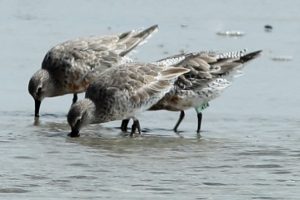
I learned that red knot 4T4 was already an adult when it received a band on May 16, 2017, making my bird at least 4 years old. More interesting is this bird who had once been is Delaware during the famous feeding frenzy for which the Delaware Bay is known, spent at least a part of this spring in South Carolina. Did this bird spend the whole winter this far north or was Seabrook Island a stop over as this bird traversed the distance from southern Argentina or the Arctic–essentially pole to pole–like most red knots? Only by making sightings like mine will the scientists ever learn about these birds behaviors.
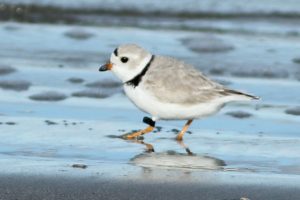
Piping plover EX received its flag as a baby in New Brunswick, Canada in 2017. The scientist who banded this bird now know where it was on April 2, 2019. This diminutive bird, now almost two years old migrated from coastal Canada to enjoy at least part of the spring in South Carolina.
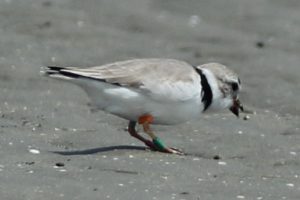
Back out on North Beach on April 8, 2019, I got a picture of another piping plover. This one had a string of colored bracelets which included an orange flag over two green bands on the left leg and a silver band (the official band) over purple or faded red on the left leg. On July 1, 2015, his bird received its markings as a baby in Michigan. Now almost 4 year old I documented its eighth migratory trip back toward the breeding grounds. While piping plovers can live to the ripe old age of 11, only a small percentage live longer than 5 years. I know I will be hunting for this bird next spring, hoping it will be one of those with a long life!
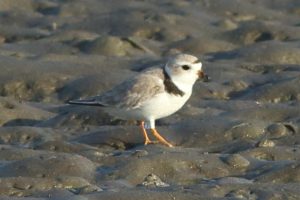
I was hooked! April 12, 2019, out on North Beach once again, I saw another piping plover with a green flag over yellow over blue on the right leg and white over yellow on the left. No details have arrived for this bird, yet. In the same area, a bird with a white flag with in black the code T7 posed for her picture. Scientists captured her as an adult bird on June 7, 2018 in Nova Scotia, making her at least 3 years old. Since she was an adult, the scientists could tell she was a female. Presumably, they can do the same with the birds whose pictures I submitted, thereby adding to their knowledge of these individuals.
Going out to North Beach (a t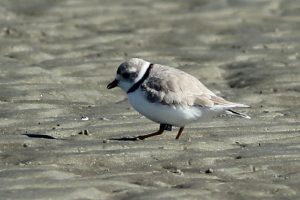 hree mile round trip on a sandy beach lugging my binoculars, spotting scope, and camera) became an obsession and on April 15, 2019, two of the piping plovers recorded earlier were still present, but in addition a bird sporting a black flag with white writing on its right leg cooperated for dozens of pictures some showed the code 78. Banded in Newfoundland and Labrador, Canada (the reports are sometimes not very specific as to the location) on July 10, 2018, the scientists now know this youngster visited South Carolina.
hree mile round trip on a sandy beach lugging my binoculars, spotting scope, and camera) became an obsession and on April 15, 2019, two of the piping plovers recorded earlier were still present, but in addition a bird sporting a black flag with white writing on its right leg cooperated for dozens of pictures some showed the code 78. Banded in Newfoundland and Labrador, Canada (the reports are sometimes not very specific as to the location) on July 10, 2018, the scientists now know this youngster visited South Carolina.
I still hope to receive news about several other birds, but realize that this is also the banders busy season. Just from these few birds, one can safely say that Seabrook Island’s North Beach provides a desirable stopping point for piping plovers that travel up and down the Atlantic coast and for birds from the mid-west.
On April 19, 2019, we left South Carolina but I now had a new passion for supporting scientists, not just through ebird, but by searching for and recording color banded birds. My new hobby!
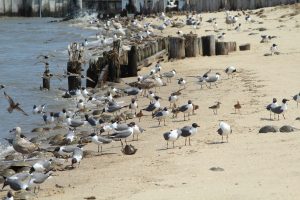
On May 19, 2019, Eileen and I sat on a tiny slip of a beach on the New Jersey Delaware Bay shore. Here we watched hundreds of horseshoe crabs going through their mating ritual. They were accompanied by thousands of shorebirds, mostly semipalmated sandpipers, sanderlings, ruddy turnstones, and red knots.
As we scanned the hordes, we could see flags. Out came the camera and clear pictures were taken of two ruddy turnstones—green flag with white writing MMT and JPY, and a sanderling C3T. Certificates of Appreciation for MMT and C3t already arrived. The male ruddy
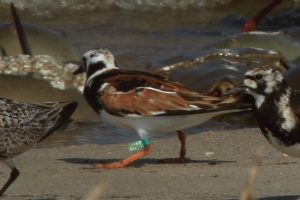
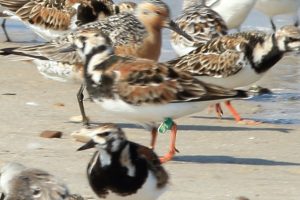
turnstone MMT was banded as an adult on May 29, 2016. Interestingly, he was banded just a few miles from my location. This bird returned to almost the exact same spot three years later and most likely has done so for at least 5 trips. How cool would it be if we could learn where this bird spent is winter and summer! Red knots are famous for making a 10,000 mile round trip every year. It is possible that this relatively small bird had already travelled over 50,000 miles in its short lifetime. Seeing such a healthy bird for a species that has shown very sharp declines is heartening.
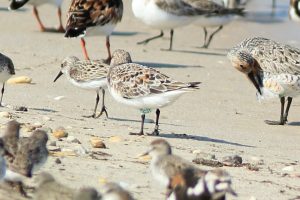
The sanderling, C3T, like the red knot received its band just a few miles from where I photographed it, but way back on May 25, 2011. Since it was an adult when banded, this bird must be at least 10 years old! One should not be too surprised that it also came back to the same location at almost the same time of year. After all, mid-May to early June is THE time for the horseshoe crabs to be generating the incredibly abundant food source these birds need to make their migration.
Unfortunately for me, the migration has progressed and the birds no longer visit my region. What is next?
This past month, life took a completely new direction: still taking pictures, but now of creatures in my yard. This should give me more fodder for my blog. So, I will put in writing to make it formal, I will endeavor to share more of my adventures in learning. Stay tuned.

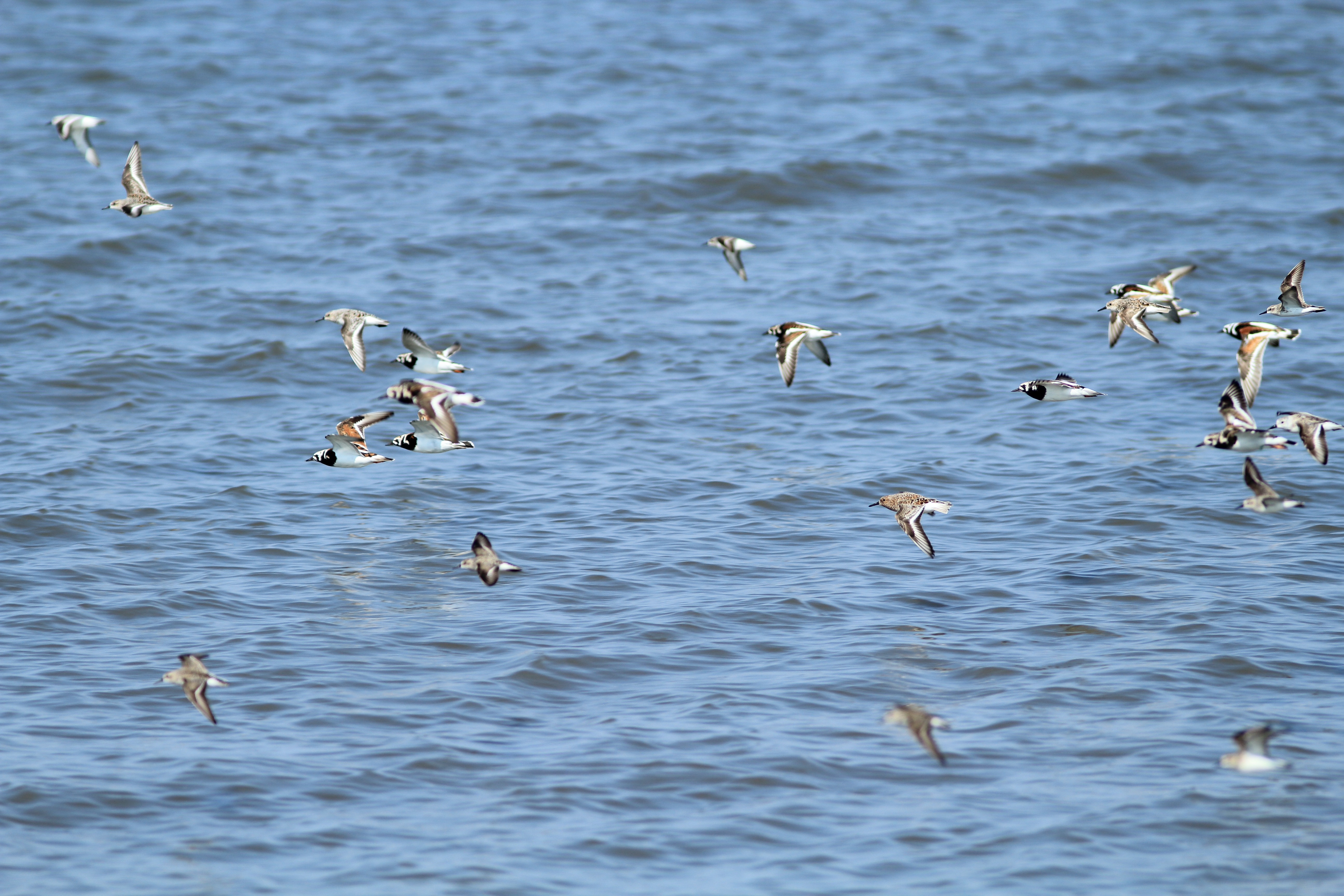
Wonderful story and glad I could share in some of your trips while here in South Carolina! I look forward to your next story!!!
Nancy
What a thrill it is to have you back! I will never tire of those magnificent shots of piping plovers, sanderlings and red knots. You are a good photographer. Thanks for sharing. It is so amazing to have PROOF that the bird you are looking at has made an incredible journey.
You are my muse. Thank you!!
Thanks for the honor!
I enjoyed ready this post, very informative with a nice personal touch. A naturalist’s retirement spent in the best way possible.
Very good, but you are aware that “my kids” know more than me (Lois Katz/Chuck Lufkin)
We are all always learning!
This is so interesting, Bob! Please write as often as you have time.
Great stuff Bob. Sounds like you are enjoying retirement and getting out there lots. Kudos!
Thank you for this! Loved reading the whole thing!
Writing is both fun and work. It is made special and worthwhile when an author know he or she is actually being read. thanks.
Well-written and fun! Love your photos, too! Seabrook is our favorite spot to visit to watch wildlife/birds! What kind of camera did you get?
Thank you for the kind words. We do enjoy our time in Seabrook.
Currently, I am using a beginner camera, a Canon Rebel 5T, but I am currently looking at either the Canon 80D or the Canon 7D Mark2.
Great read. Hurry back to the island.
Glen
Thanks, We plan to return in January.
I did not realize that your adventure with a camera had been so recently jump started. Great pics and stories. Been great having you on Seabrook in the winter both as a birder and a friend.
Our first activity in Seabrook was the SINHG trip to Yawkey where I met you, Mel, and Rob who all quickly became my friends. I have enjoyed our time together. I wish you good health and abundant happiness.
I enjoyed reading about these banded birds. Very interesting and amazing the amount of miles they cover in migration. Glad to know that you and Eileen are doing well and enjoying retirement,